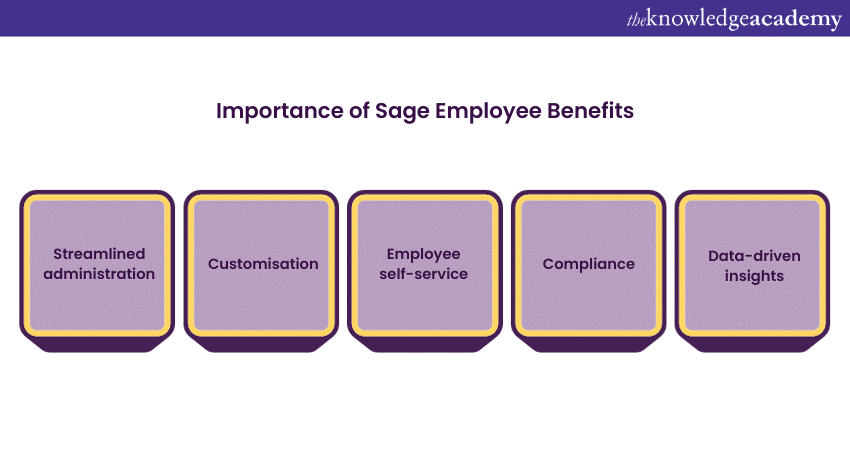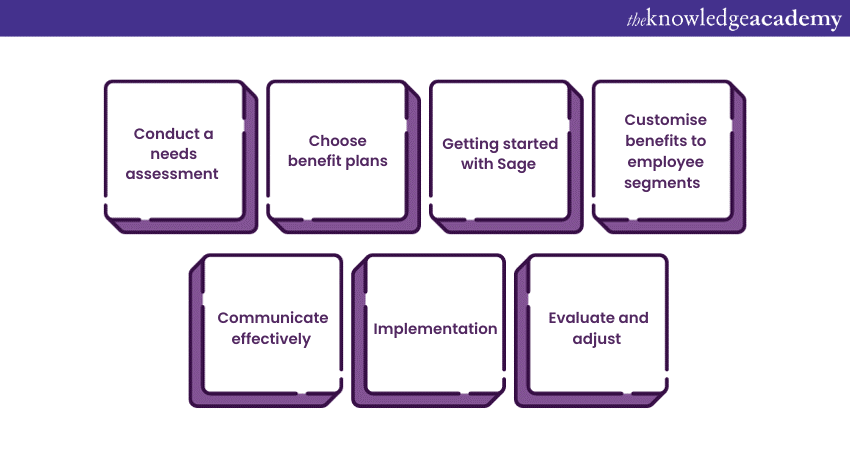We may not have the course you’re looking for. If you enquire or give us a call on +44 1344 203999 and speak to our training experts, we may still be able to help with your training requirements.
Training Outcomes Within Your Budget!
We ensure quality, budget-alignment, and timely delivery by our expert instructors.

Employee Benefits Management plays an essential role in attracting and retaining top talent within an organisation. They not only enhance job satisfaction but also contribute to employee well-being and overall productivity. One of the popular solutions for managing Employee Benefits is Sage, a comprehensive platform that simplifies Benefits Administration. In this blog on Sage Employee Benefits, you will learn the impact of Sage Employee Benefits in cultivating a flourishing workplace. Read ahead to learn more!
Table of Contents
1) What is Sage Employee Benefits?
2) Importance of Sage Employee Benefits
3) How to set up Sage Employee Benefits?
4) Conclusion
What is Sage Employee Benefits?
Employee Benefits are additional rewards or incentives that employers provide to their workers besides their salaries. The benefits can be a useful or enjoyable service or product, a discount or facility that employees can access.
A good benefits package can make employees more satisfied and loyal and improve the employer’s image. Employee Benefits can range from minor perks, such as free coffee in the office, an annual Christmas party or a subsidised canteen, to more valuable ones.
More importantly, if these benefits directly prove advantageous to the employee, personally, they are usually subject to tax. For example, if an employee has a company car that they use for both work and personal trips, they must pay tax on the personal portion of the value.
Other common benefits include healthcare plans, pension plans, childcare vouchers, extended parental leave, insurance, share options, employee share schemes and interest free season ticket loans. Some employers give employee discounts on their own products and services or arrange discounts with other providers.
Moreover, flexible benefits allow employees to select a variety of benefits that suit their preferences. These may also include wellbeing benefits (gym membership, dentistry, physio, massage or counselling) extra holiday, education and training. If a company gives benefits in return for a part of the salary, this is known as salary packaging or salary exchange.

Importance of Sage Employee Benefits
Sage offers a robust Employee Benefits platform designed to streamline the process of managing various benefits programs. Here are the reasons why Sage Employee Benefits are important in organisations:

a) Streamlined administration: Sage Employee Benefits platform offers a centralised hub for managing various benefits, from health insurance and retirement plans to wellness programs. This streamlined administration reduces the administrative burden on HR teams, helping them to focus on strategic initiatives.
b) Customisation: The platform enables organisations to tailor benefits packages to meet various requirements of their workforce. Customisation options include selecting different benefit plans, contribution levels, and eligibility criteria, ensuring that employees receive benefits that resonate with them.
c) Employee self-service: Sage Employee Benefits provide employees with a self-service portal where they can conveniently access their benefit details, make selections, and manage their choices. This allows employees to promote a sense of ownership over their benefits, leading to increased engagement.
d) Compliance: Navigating the complex landscape of Employee Benefits compliance can be challenging. Sage helps organisations stay compliant with regulatory requirements by automating processes, tracking relevant data, and generating necessary reports.
e) Data-driven insights: The platform offers data analytics tools that provide insights into Employee Benefits utilisation and preferences. These insights help organisations make informed decisions about benefit offerings and optimise their overall benefits strategy.
How to set up Sage Employee Benefits

Setting up Sage Employee Benefits is a strategic process that requires careful planning, customisation and ongoing management. By following a methodical approach, you can ensure that your employees receive a well-rounded benefits package that meets their needs and contributes to their overall well-being. Here's a detailed breakdown of each step:
Step 1: Conduct a needs assessment
Before implementing Sage Employee Benefits, it's crucial to understand the distinct needs and preferences of your employees. Conduct surveys, focus groups, or one-on-one discussions to gather insights into the types of benefits that would be most valuable to them. Some employees might prioritise healthcare coverage, while others might be more interested in wellness programs or flexible work arrangements. By collecting this data, you can tailor your benefits offerings to align with what matters most to your workforce.
Step 2: Choose benefit plans
With your strategy in place, it's time to select the benefits that will form the core of your Sage Employee Benefits package. Sage offers a variety of benefits that cater to different aspects of employee well-being. Consider including health and dental insurance options, retirement plans such as 401(k)s, paid time off, remote work options, wellness programs, and more. The goal is to create a comprehensive package that addresses both physical and emotional well-being.
Step 3: Getting started with Sage
Here’s how to get started with Sage:
1) Sign up: Begin by signing up for Sage's Employee Benefits platform. Create an account with the necessary information and credentials.
2) Company setup: Input essential details about your company, such as the number of employees, organisational structure, and any specific benefit options you plan to offer.
3) Integration: Integrate the Sage platform with your existing HR and payroll systems to ensure seamless data exchange. This integration will help automate processes like benefit enrolment and deductions, minimising errors and administrative tasks.
Step 4: Customise benefits to employee segments
Sage Employee Benefits allows you to personalise the platform to reflect your company's branding and culture. Customise the user interface and communication materials to maintain a consistent and cohesive experience for your employees. Additionally, tailor benefits offerings based on factors like employee demographics, job roles, and preferences. This level of customisation enhances the relevance and effectiveness of the benefits package, making it more valuable to your workforce.
Unlock the path to effective Financial Management through our specialised Accounting and Finance Training register today for enhanced skills!
Step 5: Communicate effectively
Implementing new benefits can be a significant change for your employees. Effective communication and education are essential to ensure that they understand and appreciate the value of the offerings. Host workshops, webinars, or informational sessions to explain each benefit in detail. Use clear and accessible language to describe how employees can enrol, access, and utilise the benefits through the Sage platform. Address any questions or concerns they may have and provide easy-to-follow guides or resources for reference.
Step 6: Implementation
Collaborate closely with the implementation team from Sage Employee Benefits to smoothly integrate the chosen benefits into your HR infrastructure. This step involves technical setup, such as configuring the platform to reflect the customised benefits package, creating user accounts for employees, and ensuring that the enrolment process is user-friendly. Test the platform thoroughly to identify and resolve any potential issues before launching it to your employees.
Step 7: Evaluate and adjust
Setting up Sage Employee Benefits is not a one-time task; it requires ongoing management and evaluation. Continuously monitor the usage and effectiveness of the benefits over time. Collect all feedback from employees through surveys or feedback sessions to understand their satisfaction levels and identify any areas for improvement. Regularly review the benefits package to ensure that it remains aligned with the evolving needs of your workforce and the changing landscape of Employee Benefits.
Conclusion
Investing in Sage Employee Benefits goes beyond the bottom line; it's an investment in your team's well-being and the overall success of your organisation. By offering comprehensive benefits that cater to various aspects of your employees' lives, you develop an environment where they can grow both personally as well as professionally.
Enhance your skills in managing Employee Benefits with our comprehensive Sage 50 Accounts Training - register today!
Frequently Asked Questions

Sage Employee Benefits significantly bolster employee retention and attraction by offering tailored packages encompassing health insurance, retirement plans, and wellness programs. These benefits not only enhance financial security and well-being but also demonstrate a commitment to employees' holistic needs.

Sage contributes to a positive company culture by prioritising employee well-being and satisfaction. Through comprehensive benefits packages, including health insurance, retirement plans, and wellness programs, Sage demonstrates a commitment to supporting its employees' holistic needs.

The Knowledge Academy takes global learning to new heights, offering over 30,000 online courses across 490+ locations in 220 countries. This expansive reach ensures accessibility and convenience for learners worldwide.
Alongside our diverse Online Course Catalogue, encompassing 17 major categories, we go the extra mile by providing a plethora of free educational Online Resources like News updates, Blogs, videos, webinars, and interview questions. Tailoring learning experiences further, professionals can maximise value with customisable Course Bundles of TKA.

The Knowledge Academy’s Knowledge Pass, a prepaid voucher, adds another layer of flexibility, allowing course bookings over a 12-month period. Join us on a journey where education knows no bounds.

The Knowledge Academy offers various Accounting & Finance Training Courses, including Finance for Non-Financial Managers, Financial Management Course and more. These courses cater to different skill levels, providing comprehensive insights into the 12 Best Financial Management Software.
Our Business Skills Blogs cover a range of topics related to SAGE, offering valuable resources, best practices, and industry insights. Whether you are a beginner or looking to advance your Business Skills, The Knowledge Academy's diverse courses and informative blogs have you covered.
Upcoming Accounting and Finance Resources Batches & Dates
Date
 Sage 50 Accounts Training
Sage 50 Accounts Training
Fri 3rd Jan 2025
Fri 10th Jan 2025
Fri 17th Jan 2025
Fri 24th Jan 2025
Fri 7th Feb 2025
Fri 14th Feb 2025
Fri 21st Feb 2025
Fri 28th Feb 2025
Fri 7th Mar 2025
Fri 14th Mar 2025
Fri 21st Mar 2025
Fri 28th Mar 2025
Fri 4th Apr 2025
Fri 11th Apr 2025
Fri 2nd May 2025
Fri 9th May 2025
Fri 16th May 2025
Fri 23rd May 2025
Fri 6th Jun 2025
Fri 13th Jun 2025
Fri 20th Jun 2025
Fri 27th Jun 2025
Fri 4th Jul 2025
Fri 11th Jul 2025
Fri 18th Jul 2025
Fri 25th Jul 2025
Fri 8th Aug 2025
Fri 15th Aug 2025
Fri 22nd Aug 2025
Fri 29th Aug 2025
Fri 5th Sep 2025
Fri 12th Sep 2025
Fri 19th Sep 2025
Fri 26th Sep 2025
Fri 3rd Oct 2025
Fri 10th Oct 2025
Fri 17th Oct 2025
Fri 24th Oct 2025
Fri 7th Nov 2025
Fri 14th Nov 2025
Fri 21st Nov 2025
Fri 28th Nov 2025
Fri 5th Dec 2025
Fri 12th Dec 2025
Fri 19th Dec 2025
Fri 26th Dec 2025







 Top Rated Course
Top Rated Course


 If you wish to make any changes to your course, please
If you wish to make any changes to your course, please


